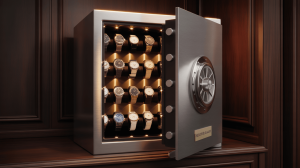A safe is no longer just a bulky metal box tucked away in a closet. Today’s modern homes demand sleek solutions that blend security, convenience, and technology. Imagine a single unit that not only locks away valuables but also organizes jewelry, winds automatic watches, and connects to your smartphone. This introduction explores why multifunctional safes have become essential design elements in contemporary living spaces, how they elevate daily routines, and what features distinguish them from traditional safes.
1. Integrating Security with Smart Technology
Modern safes fuse robust security measures with advanced tech. Rather than relying solely on mechanical locks, they often include biometric fingerprint scanners that grant instant access to authorized users. Voice activation can integrate them into existing smart home ecosystems like Amazon Alexa or Google Home. This means you can check lock status or receive alerts via voice commands. The safe’s electronic components sync with a dedicated app, providing real-time notifications of any tampering or door openings. Enterprise-grade encryption ensures data remains secure, giving homeowners peace of mind without sacrificing convenience.
2. Beyond Fire Resistance: Multi-Protection Standards
Traditional safes focus on fire or burglar protection in isolation. Multifunctional designs combine both. High-end models use composite fireboard panels and intumescent gaskets to meet UL 72 Class 350 ratings, protecting contents for 30–60 minutes at 1,200°F. Simultaneously, their 12–14 gauge steel bodies and multi-point locking bolts achieve UL RSC or ETL burglary certifications. Hidden hinges resist pry attacks. The integrated approach ensures jewelry, documents, electronics, and automatic watches remain safe from fire, moisture, and theft. This dual-standard protection transforms a safe into a comprehensive vault.
3. Built-In Watch Winder Functionality
Automatic watches require consistent motion to maintain accuracy. Without regular movement, lubricants can congeal and timekeeping drifts, leading to costly maintenance. Built-in winding modules simulate wrist rotation at programmable turns-per-day (TPD) settings, ranging from 650 to 2,500. Users can select clockwise, counterclockwise, or bi-directional rotation to match each watch’s specifications. Precision Japanese or Swiss motors run under 25 dB, ensuring whisper-quiet operation. Rubber-dampened mounts absorb any vibration, preventing disturbance in bedrooms or home offices. Over time, this precise winding preserves the life of watch movements and simplifies daily wear.
| Winding Feature | Specification | User Benefit |
|---|---|---|
| TPD Range | 650–2,500 turns/day | Matches manufacturer requirements |
| Rotation Options | CW, CCW, Bi-directional | Prevents over-winding and wear |
| Noise Level | < 25 dB | Suitable for quiet environments |
4. Organizing Jewelry and Small Valuables
A multifunctional safe’s interior often includes modular compartments designed for jewelry and small valuables. Velvet-lined drawers and foam inserts protect delicate items from scratches and tangles. Ring rolls hold bands upright, preventing contact damage. Earring posts keep pairs together, while necklace hooks suspend chains to avoid knots. Drawer dividers accommodate bracelets, cufflinks, or coins. Some models include hidden lower trays for cash, passports, or documents. This thoughtful organization eliminates clutter and ensures each item remains easy to locate, transforming the safe into a curated storage solution.
5. Climate and Moisture Management
Precious metals, leather watch straps, and antique documents can degrade in unstable environments. Modern safes employ IP54-rated door seals to block dust and moisture. Passive desiccant chambers absorb excess humidity, while active dehumidifiers automatically regulate relative humidity between 40–50%. Digital hygrometers display real-time levels, allowing homeowners to adjust settings via on-panel controls or a smartphone app. This controlled microclimate prevents tarnish, strap cracking, and mildew formation, reducing the need for costly restoration or cleaning.
6. Aesthetic Design and Home Integration
A safe designed for modern interiors must complement decor rather than clash. Options range from matte-black powder-coat steel to bespoke walnut or ebony veneers. Full-grain leather-wrapped exteriors create a boutique feel in dressing rooms or studies. Flush-mount keypads and biometric panels integrate seamlessly without protruding hardware. Some units feature tempered glass display windows framed in brushed aluminum, converting the safe into a focal point that showcases prized watches and jewelry. Motion-activated LED lighting illuminates interiors with a soft glow, making the safe feel more like art than merely a security device.
| Exterior Finish | Material | Design Impact |
|---|---|---|
| Matte-Black Steel | Powder-coated | Sleek, minimalist look |
| Walnut Veneer | Real wood veneer | Warm, classic elegance |
| Leather Wrap | Full-grain leather | Luxurious, tactile finish |
7. Silent, Vibration-Free Operation
A modern safe should operate without disrupting daily life. High-end winding modules use precision bearings and brushless motors to keep noise levels under 25 dB—comparable to a soft whisper. Rubber-dampened motor mounts absorb vibrations, preventing rattling sounds or transfer to nearby furniture. Soft-close hinges eliminate slam noises on door closure. Silent locking bolts reduce audible clicks. Together, these features ensure the safe can reside in bedrooms, living rooms, or home offices without drawing attention or disturbing activities.
8. Power Efficiency and Backup Solutions
Electronic locks and winding modules demand reliable power. Multifunctional safes include an AC adapter for continuous home operation and a rechargeable lithium-ion battery for backup during outages. Low-battery LED indicators and smartphone notifications warn users before power depletion. In case of complete electronic failure, a hidden mechanical override key or combination dial ensures manual access. This layered approach balances energy efficiency with uninterrupted security and winding functions.
9. Smart Home Ecosystem Compatibility
Beyond standalone features, modern safes integrate into popular smart home ecosystems. They can connect with hubs like Amazon Alexa, Google Home, or Apple HomeKit. Voice commands allow users to query lock status or receive real-time security alerts through existing home speakers. Integration with home automation scenes can trigger lights, cameras, or alarms if tampering is detected. This seamless compatibility extends the safe’s functionality, making it a central node in a broader security and convenience network.
| Smart Integration | Functionality | Home Ecosystem Benefit |
|---|---|---|
| Voice Commands | Query lock status, alerts | Convenience and hands-free control |
| Hub Compatibility | Connect to Alexa/Google Home | Unified home automation |
| Security Automation | Trigger cameras/alarms if tampered | Enhanced, proactive protection |
10. Accessibility and User Experience
Ease of use is paramount. Biometric fingerprint scanners allow swift access without memorizing codes or carrying keys. Tactile keypad buttons with backlighting ensure visibility in low-light conditions. OLED touchscreen panels offer intuitive menus for winding settings, humidity controls, and connectivity options. Ergonomic handles and gas-spring-assisted doors make opening large units effortless. Well-designed interiors use soft-close drawers on ball-bearing slides for smooth operation. These user-centric features reduce frustration and enhance daily interactions.
11. Fire and Burglary Certification Breakdown
Not all security certifications are equal. UL RSC (Residential Security Container) and ETL burglary ratings confirm a safe’s resilience against forced entry for specified durations. UL 72 Class 350 fire ratings indicate that contents remain under 350°F for a set time, preserving delicate materials. Some premium safes exceed standard fire ratings with extended durations—up to 60 minutes. Document certification (UL 350) specifically protects paper items. Understanding these certifications ensures the safe meets your protection priorities.
12. Installation and Anchoring Essentials
Even the strongest safe can be defeated if not properly anchored. First, locate floor joists or wall studs with a reliable stud finder. Use heavy-duty lag bolts or sleeve anchors rated for the safe’s fully loaded weight. Level the unit before tightening to prevent door binding. Conceal anchor heads under interior liners or trim for an uncluttered look. For larger or built-in models, professional installation guarantees stability and optimal security, preventing tipping or prying.
| Installation Step | Action | Best Practice |
|---|---|---|
| Stud/Joist Location | Use stud finder to mark positions | Double-check markings before drilling |
| Anchor Selection | Heavy-duty lag/sleeve anchors | Match anchor strength to weight load |
| Leveling | Adjust feet or shims before bolt-down | Prevents door binding and ensures smooth operation |
13. Budget and Value Analysis
Multifunctional safes span a wide price range. Entry-level models begin at $1,500 for a basic safe with a 2–4 watch winder and simple jewelry drawers. Mid-range units ($2,500–$5,000) add climate control, LED lighting, and smart app integration. Premium safes ($5,000+) offer custom veneers, biometric locks, extended fire projections up to 60 minutes, and enterprise-grade connectivity. Insurance discounts for certified burglary and fire protection can offset part of the initial investment. Over time, reduced watch maintenance and fewer jewelry repairs enhance overall savings.
14. Maintenance and Care Best Practices
Proper maintenance keeps the safe performing flawlessly. Dust exterior surfaces weekly using a microfiber cloth to protect finishes. Run empty winding cycles monthly to keep motors from seizing. Test biometric sensors, electronic locks, and sensors quarterly. Replace desiccant packs every 6–12 months to maintain ideal humidity. Swap backup batteries annually to ensure uninterrupted operation. Lubricate mechanical locks per manufacturer instructions. Keep a service log of maintenance dates and any issues to prevent major failures.
15. Final Considerations for Modern Homes
When choosing a safe that does more than lock, weigh your priorities: security, watch winding, jewelry organization, smart connectivity, and design. Measure available space and consider the safe’s footprint. Factor in your collection size and future growth. Compare certifications, user reviews, and warranty coverage from reputable brands. If you value convenience, technology, and style alongside robust protection, a multifunctional safe becomes an indispensable element of a modern home.
FAQ
Q1: Can I store both quartz and automatic watches in a multifunctional safe?
Yes. Quartz watches remain in static trays, while automatics sit in dedicated winding bays designed to mimic wrist movement.
Q2: How often should I replace desiccant packs?
Replace desiccant packs every 6–12 months, depending on local humidity, to maintain a stable 40–50% relative humidity level.
Q3: Are smart connectivity features prone to hacking?
Top models employ AES encryption and require strong, unique passwords. Regular firmware updates reduce vulnerability to hacking attempts.
Q4: Do these safes require professional installation?
For larger or built-in units, professional installation is recommended to ensure proper anchoring to floor joists or wall studs and prevent door binding.
Q5: How can I ensure my safe remains quiet?
Choose models with precision brushless motors under 25 dB and rubber-dampened mounts. Soft-close hinges and silent locking bolts further minimize noise, making the safe suitable for any room.







